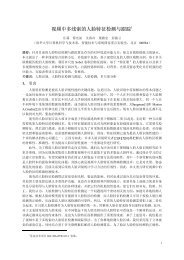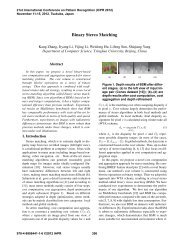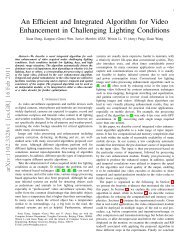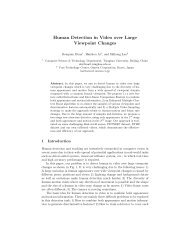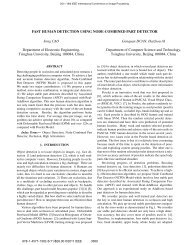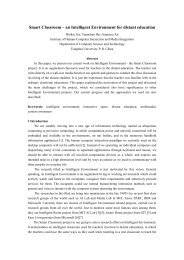An Integrated and Scalable Approach to Video Enhancement in ...
An Integrated and Scalable Approach to Video Enhancement in ...
An Integrated and Scalable Approach to Video Enhancement in ...
Create successful ePaper yourself
Turn your PDF publications into a flip-book with our unique Google optimized e-Paper software.
8<br />
…<br />
1 2 3 4 5 6 7 8 9 ... W-1 W<br />
Fig. 10: Fast calculation of 1-D local m<strong>in</strong>imum value.<br />
<strong>in</strong> the YUV space <strong>to</strong> match the <strong>in</strong>put format of most practical<br />
video applications:<br />
Y out (x) =<br />
U out (x) =<br />
V out (x) =<br />
Y <strong>in</strong> (x) − ωA m<strong>in</strong>( m<strong>in</strong> ( I(y)<br />
c y∈Ω(x)<br />
A ))<br />
1 − ω m<strong>in</strong>( m<strong>in</strong> ( I(y)<br />
c y∈Ω(x)<br />
A )) , (11)<br />
U <strong>in</strong> (x) − 128<br />
1 − ω m<strong>in</strong>( m<strong>in</strong><br />
c<br />
( I(y)<br />
y∈Ω(x)<br />
A<br />
V <strong>in</strong> (x) − 128<br />
1 − ω m<strong>in</strong>( m<strong>in</strong><br />
c<br />
( I(y)<br />
y∈Ω(x)<br />
A<br />
))<br />
+ 128, (12)<br />
))<br />
+ 128. (13)<br />
F<strong>in</strong>ally, <strong>to</strong> further speed up the implementation, we exploited<br />
the <strong>in</strong>herent redundancies <strong>in</strong> the pixel-wise calculations of the<br />
m<strong>in</strong>imization <strong>in</strong> equations (10) - (13), which corresponds <strong>to</strong> a<br />
complexity of k 2 × W × H comparisons for an <strong>in</strong>put frame of<br />
resolution W ×H, <strong>and</strong> a search w<strong>in</strong>dow (for the m<strong>in</strong>imization)<br />
of size k × k pixels. To expedite the process, we first f<strong>in</strong>d<br />
<strong>and</strong> s<strong>to</strong>re the smaller of every two horizontally neighbor<strong>in</strong>g<br />
pixels <strong>in</strong> the frame us<strong>in</strong>g a slid<strong>in</strong>g horizontal w<strong>in</strong>dow of size<br />
2, requir<strong>in</strong>g W × H comparisons. Then, by aga<strong>in</strong> us<strong>in</strong>g a<br />
horizontal slid<strong>in</strong>g w<strong>in</strong>dow of 2 over the values s<strong>to</strong>red <strong>in</strong> the<br />
previous step, we can f<strong>in</strong>d the m<strong>in</strong>imum of every 4 horizontally<br />
neighbor<strong>in</strong>g pixels <strong>in</strong> the orig<strong>in</strong>al <strong>in</strong>put frame. This process is<br />
repeated <strong>in</strong> both the horizontal <strong>and</strong> vertical directions, until we<br />
have found the m<strong>in</strong>imum of all k × k neighborhoods of the<br />
<strong>in</strong>put. It is easy <strong>to</strong> f<strong>in</strong>d that such a strategy has a complexity<br />
of roughly 2 log 2 k × W × H comparisons, as opposed <strong>to</strong><br />
k 2 × W × H for the simplistic implementation. This process<br />
is illustrated for one row of W pixels <strong>in</strong> Fig. 10, where the<br />
red <strong>and</strong> black l<strong>in</strong>es refer <strong>to</strong> the comparisons made, each with<br />
a slid<strong>in</strong>g w<strong>in</strong>dow of 2 values.<br />
Fig. 11: Example of low light<strong>in</strong>g video enhancement algorithm:<br />
Orig<strong>in</strong>al <strong>in</strong>put (Left), <strong>and</strong> the enhancement result<br />
(Right).<br />
Fig. 12: Example of high dynamic range video enhancement<br />
algorithm: Orig<strong>in</strong>al <strong>in</strong>put (Left), <strong>and</strong> the enhancement result<br />
(Right).<br />
Examples of the enhancement outputs for low light<strong>in</strong>g, high<br />
dynamic range <strong>and</strong> hazy videos are shown <strong>in</strong> Fig. 11, Fig. 12<br />
<strong>and</strong> Fig. 15 respectively. As we can see from these figures,<br />
the improvements <strong>in</strong> visibility are obvious. In Fig. 11, the<br />
yellow light from the w<strong>in</strong>dows <strong>and</strong> signs such as “Hobby<br />
Town” <strong>and</strong> other Ch<strong>in</strong>ese characters were recovered <strong>in</strong> correct<br />
color. In Fig. 12, the headlight of the car <strong>in</strong> the orig<strong>in</strong>al <strong>in</strong>put<br />
made letters on the license plate very difficult <strong>to</strong> read. After<br />
V. EXPERIMENTAL RESULTS<br />
To evaluate the proposed approach, a series of experiments<br />
were conducted with a W<strong>in</strong>dows PC (Intel Core 2 Duo<br />
processor runn<strong>in</strong>g at 2.0 GHz with 3G of RAM) <strong>and</strong> an iPhone<br />
4. On the iPhone, our software could process the images <strong>and</strong><br />
videos from the camera directly or from the pho<strong>to</strong> album.<br />
After the process<strong>in</strong>g is complete, the output would be shown<br />
on the screen <strong>and</strong> saved <strong>in</strong> the pho<strong>to</strong> album au<strong>to</strong>matically. The<br />
resolution of test videos <strong>in</strong> our experiments was 640 × 480 on<br />
PC <strong>and</strong> 192 × 144 on iPhone 4. The enhancement effects <strong>and</strong><br />
process<strong>in</strong>g speed are listed below. Due <strong>to</strong> time constra<strong>in</strong>ts,<br />
we only implemented the frame-by-frame base l<strong>in</strong>e system on<br />
the iPhone <strong>and</strong> did not employ many further possible ways<br />
of optimization on the PC platform (e.g. by us<strong>in</strong>g assembly<br />
cod<strong>in</strong>g).<br />
Fig. 15: Example of haze removal algorithm: Orig<strong>in</strong>al <strong>in</strong>put<br />
(Left), <strong>and</strong> the enhancement result (Right).<br />
Fig. 16: Example of ra<strong>in</strong>y video enhancement us<strong>in</strong>g haze<br />
removal algorithm: Orig<strong>in</strong>al <strong>in</strong>put (Left), <strong>and</strong> the enhancement<br />
result (Right).



